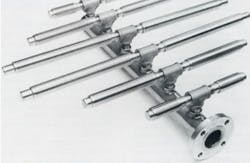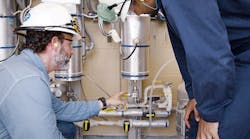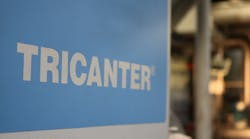Filtration is used in addition to regular coagulation and sedimentation for removal of solids from surface water or wastewater. Wastewater filtration helps users meet more stringent effluent discharge permit requirements, for example. Filtration, usually considered a simple mechanical process, actually involves the mechanisms of adsorption, straining, sedimentation, interception, diffusion and inertial compaction.
Many industries utilize media-bed filtration. This use may take the form of ion exchange for water softening/demineralization, sand filtration, activated carbon or other fluid treatment processes. However, whether the application is in a water utility, a power utility, pulp and paper, steel, or any of the process industries, chemicals or pharmaceuticals, problems tend to be very similar.
Time and again, the same common complaints arise in the media bed filtration process:
- Leaking resin or media
- Excessive pressure drop
- Filter screen clogging
- Excessive backwash requirements
These complaints can be relieved by the use of properly designed and specified equipment and equipment internals (arguably the most important investment in media bed filtration). Unfortunately, most new equipment and retrofit inquiries do not include enough hard and specific data to ensure the proper product selection.
The nonspecific inquiry
A typical inquiry to the filtration product manufacturer might ask for a set of header laterals to form a distribution system for an activated carbon column or demineralizer tank. The manufacturer may be supplied with:
- Request for the lateral system
- Overall size and configuration of desired
system - Flow rate
This data can certainly be used to produce a set of header laterals. In fact, a great variety of header laterals might be produced, all conforming to these rather nonspecific specifications. The question is: Which design would do the best job for the specifier?
In the ideal situation, the manufacturer’s application engineers will return to their customers with a set of questions designed to elicit more specific information about the customers’ overall requirements. For example, they may want to discuss ramifications of the filtration process to make certain the process is fully understood and the problem is pinned down.
These engineers may also suggest specific upgrades. Wedge flow is often recommended instead of wire-cloth mesh for its characteristics of strength and cleaning ease. Wedge flow can also be installed over drilled pipe. This design offers improved support and better flow into the lateral, ensuring uniform distribution so that all media is used throughout the bed. Of course, this design costs more than an off-the-shelf "quick-fix."
Ask the right questions
In order to make sure that the product being ordered for the system is suitable for the process, the plant engineer should ask, or make sure that his purchasing agent asks, questions like:
- Will the product withstand system pressures?
- Is it designed to avoid clogging?
- If it does clog, will it withstand the strain or is it likely to collapse and lose the media?
- Is it sized to retain the particles in normal use?
- Will it pass the desired flow?
- Is it designed to minimize pressure loss?
- Has corrosion been considered?
- Are proper alloys available and specified?
- Will the product fit the system without necessity for field modification?
- Can it be successfully back-washed, or must it be removed for cleaning?
- If it must be removed, is it easy to take out and put in again?
- What is its expected life?
Obviously, this is a lot to consider. However, considerations like these are all part of obtaining an optimum product for the desired application. In fact, it is because such questions are addressed that a retrofit may often be an improvement over the original design.
The ‘silent’ problem
The pulp and paper industry tends to employ large, horizontal sand filters, gravity-fed tanks and river water. Efficient, uniform collection is important because channeling leads to liquid concentration and a premature regeneration need. This is a problem not recognized by many plant operators. The result is a system that demands excessive downtime and wastes backwash water.
In any process where a fluid is being distributed through media, it is important to retain uniform cross-sectional velocity — forcing the fluid to flow uniformly and contact all media in the bed. Channeling is always the enemy. If the fluid is allowed to run into channels, the media will be exhausted in the neighborhood of the channels while it is still fresh and unused (essentially wasted) in other areas. Channeling leads to the premature need for regeneration.
Vessel internals determine flow characteristics and therefore its ultimate performance. This has been demonstrated in many retrofit applications, where operating time has been increased 15% to 30% before backwash is required.
However, uniform flow and a channeling tendency are difficult to predict on the basis of experience alone. Technology-oriented manufacturers use electronic design automation (EDA) to supply the answers. For example, finite element analysis (FEA) is used to computer create the specific working environment of any existing or projected filtration unit.
The FEA software package allows application engineers, working with customer-supplied process data like flow rates and pressures, to perform a full analysis of the specific situation and/or problems, and suggest optimal solutions.
Specific considerations
Opening size: In water treatment processes like ion exchange, the function of the screen is to keep the resin beads in place, while facilitating fluid flow through the bed. Ion exchange resins are tiny beads of a very uniform size. If the specification calls for 12/l000ths openings, it is important to maintain that size. An opening 15/1000ths is too large, allowing the resin to leak out. On the other hand, 8/l000ths is too restrictive, impeding flow and leading to clogging. Either concession will involve a noticeable performance drop.
Materials of construction: The typical liquid "seen" by a filtration system is water. It can be waste water or boiler feed water, river water, brackish water, sea water or ultrapure water. In the process industries, filtration may also involve a variety of chemicals. Fortunately, most of these fluids can be handled by elements made of the appropriate stainless steel, nickel alloy or titanium. The customer should make sure the supplier can provide a material that functions well with the specific system fluid used.
PVC internals: Some older filtration systems were supplied with PVC (polyvinyl chloride plastic) laterals slotted to retain the media. PVC offers good corrosion resistance but poor structural stability. Flow velocity tends to cause the plastic to flex, altering slot size and configuration and resulting in pressure drop, media loss — or sometimes both. Nevertheless, mesh-wrapped PVC rods can sometimes be applied successfully.
Wire cloth vs. wedge flow: Wire-cloth screening is often used with good results in filtration applications, but does not provide the reliability of wedge flow. Since the wires that make up the cloth are round in cross-section, there is always a tendency for it to clog. Triangular cross-section wedge-flow is easier to backwash. In addition, water pressures, system stresses and careless handling can cause abrasions or tears in the wire cloth. For these reasons, many engineers prefer the strength, clog resistance, ease of backwashing and dimensional stability of wedge flow.
These considerations make it clear that the manufacturing of filter internals is as important as the design of the equipment itself.
Final words
In today’s plants, filtration products are just one component among many — but very important to plant functioning. In some circumstances, the failure of just one element can bring down an entire operation.
For long-term, reliable operation, it is important to obtain the optimum product. It is also wise to obtain that product from a supplier who can offer engineering and application assistance, including the latest computer aided design analysis, to ensure the best possible match with the customer’s own conditions of service.
E. Marvin Greenstein is director of engineering with Newark Wire Co. Clifton, N.J.-based Newark Wire Co., established in 1911, is a recognized leader in the wire cloth industry to markets including aerospace, pharmaceutical, food, chemical, automotive, medical, environmental and others. The company is uniquely positioned to offer industry a broad selection of reliable, high quality wire cloth products and services, whether roll goods, cut pieces, custom-woven wire cloth or custom fabricated parts.


